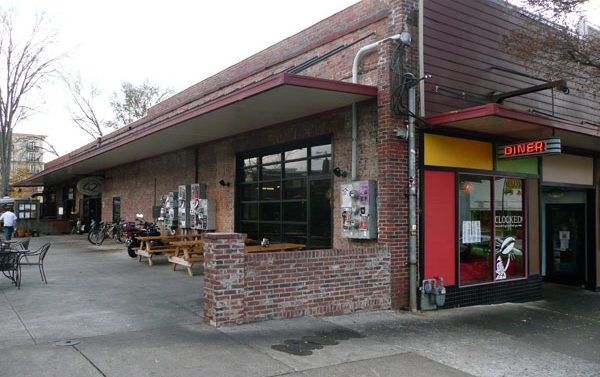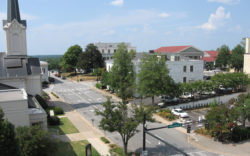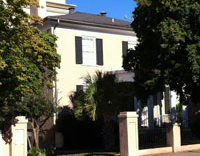Walmart Rising: Athens has suffered from poverty and a somewhat weak economy for a while now. Recently, a stranger rode in from out of town, offering to give us the solution to all our problems: a big, glitzy mixed-use development, with new property and sales tax revenues aplenty. Our budget and our economy saved in one fell swoop.
There is no deus ex machina, no silver bullet; if Athens is going to turn itself around, it’s not going to be purely based on the good intentions of a private developer. Those folks are in it to make money, and any broader benefits of the project being developed by Selig Enterprises on the Armstrong & Dobbs property are ultimately incidental. Our elected leadership still seems uninterested in letting Athens develop a vision for itself to prepare for eventualities like these, so that the overall interests of the community can be more than an afterthought.
So, how exactly will this project, as designed so far, affect us more broadly? Selig’s renderings illustrate an idyllic world in which we all drive sports cars and everyone is holding hands (seriously, look!). While there are some vague and questionable claims about new sales taxes and new jobs, what these drawings subtly imply is that in this development, you will be rich and find love. You’re supposed to get the warm fuzzies looking at these graphics, and that’s not the way for objective evaluation.
Walmart will not get you laid. These drawings, just like all the information put out to this point by Selig, is marketing, plain and simple. A closer look at the renderings reveals some fundamental problems with the project. There are angles that have purposefully been not shown, and the details in these glossy watercolors are smudged to be seen only in the best light.
Let’s consider that idyllic main street scene first. Tucked way in the back there is the Walmart (here a “Good Food”) with only its entrance apparent; trouble is, the entrance is the only place a building like this typically has windows. You can see blank brick walls sneaking out of view, just like they would out in the ‘burbs, at the end of a long parking lot. The other big problem here is the flat street shown. Anybody who’s been to the site knows that it’s pretty darned steep, so where’s the grade? Most likely, this development will hang off the top of the Oconee Street hill like a diving board, with its far end pretty high above Wilkerson Street and parking wedged underneath, so that it is technically “underground.” Expect an approach into downtown Athens from the east dominated by retaining walls, bermed slopes and the back end of a Walmart looming high above. Welcome to the Classic City!
It’s obvious that this one block is the only part of the development that really matters. With the exception of Oconee Street, which has to be just inviting enough to lure people in, most of the outward-facing parts of the project are parking, or ramps to parking. Our future rail-to-trail, which could become an iconic amenity for the community, will instead feel like a back alley. Jo Ann Chitty of Selig assures me that “green walls” will be used to screen these unsightly elements. Green walls elsewhere are typically highly engineered vegetative structures. Chitty is proposing vines growing up a wire screen. This tells me that Selig is not interested in spending a dollar more than necessary on materials; they place no value on our rail-to-trail, and intend to do the bare minimum to hide the ugly truth behind that idyllic main street.
School Preservation: The extension of our local educational local option sales tax (E-LOST) passed a few weeks ago, and one of the first projects to be tackled is Barrow Elementary, in Five Points. The school district held a community forum to update teachers, parents and community members about its progress in developing the design. The design team has been looking at what aspects of that historic school are most integral, and how much existing building to take away in order to do something logical with the new elements to be added. The solution they’re working on involves a new, long, two-story building running across the back of the old building, with two historic wings preserved in the front.
Within the school, there are a lot of interesting ideas about what a modern arrangement of classrooms means, and all the different things a school can do. It’s exciting, and Barrow has the potential to become a model not only in the community, but across the state.
The school district’s preservation ethic will continue over on the Eastside as well, with the old Gaines School (soon to be Maxine Easom Elementary) finally getting renovated. That facility has been a workhorse for the school district, and it will finally get the upgrades it deserves.
Due to the phasing of this school’s new construction overlapping with Barrow’s inhabitation of the space while construction goes on in Five Points, a new building is likely to be built behind the current footprint, with the old portions being demolished after Barrow has moved into its new space. The historic portion of the school is likely to be saved, but will be a great distance from the new campus. With the great job the school district has been doing on historic preservation, the building is going to be kept, but the problem of its new use is a tricky one.
My suggestion: In the process of developing the SPLOST 2011 project list, a branch library for the Eastside was initially suggested (although it ultimately did not make it to the final list). While Southeast Clarke Park was proposed as the home for that library, somewhere closer to the soon-to-be four schools along the Gaines School Road corridor makes much more sense. Turning the historic schoolhouse over to the county for such a use makes a lot of sense: that sort of proximity to schools already exists with the main ACC Library, adjacent to Clarke Middle and Alps Road Elementary. Imagine that old historic schoolhouse turned into a unique community focal point for the Eastside.
As a point of comparison, it’s the kind of opportunity that Walmart developer Selig should be looking for, instead of wiping out so many historic buildings on the outskirts of downtown.
Like what you just read? Support Flagpole by making a donation today. Every dollar you give helps fund our ongoing mission to provide Athens with quality, independent journalism.










